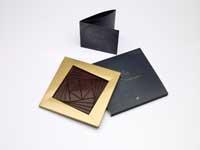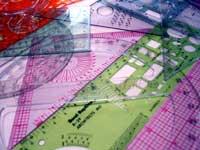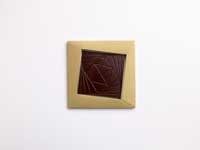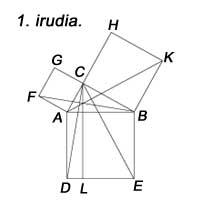Chocolate of Pythagoras
2010/05/02 Kortabitarte Egiguren, Irati - Elhuyar Zientzia

Surely you will never have imagined that to make a chocolate tablet mathematics would be helpful or you would have to apply mathematical formulas, right? Here is an example of this delicious whim. In the final creation of the Catalan chocolate maker Enric Rovira the important component has been mathematics. “It is the first time I know that chocolate is a mathematical problem” says the chocolate maker.
However, it has not been a solo work. For this purpose, the chocolate maker has had the collaboration of a designer and a mathematician. In fact, the chocolate maker Enric Rovira, the designer Santos Bregaña of the design studio Laia de San Sebastián, and the mathematician Enrique Zuazua have created a design chocolate tablet. The theorem of Pythagoras has been the starting point of this piece. The Greek philosopher and mathematician Pythagoras proposed this theorem and says that the square of the catets of a straight triangle is equal to the square of hypotenuse.
All triangles equal surface area

A mathematical problem has been applied to chocolate. (Photo: José Luis López de Subiria ).
When listening to the theorem of Pythagoras you can think that chocolate is formed by triangles or triangles, and so it is. Leaving aside the typical square or rectangular curts, the tablet is made up of rectangular triangles and several concentric squares. In addition, after this chocolate tablet hides a mathematical problem. Therefore, all triangles, although their appearance is different, have the same weight. After all, the goal is to take the part you take, eat the same amount of chocolate.
If we look at the design or drawing, therefore, those that appear different parts or fragments have the same surface. The designer Bregaña had clear the image itself, but he did not know how to calculate those proportions. It represented a mandala of five concentric squares. Out of each square were four right triangles, that is, a total of 20 triangles were obtained. All triangles have the same surface, although their appearance is different.
The mathematician Enrike Zuazua gave the solution to the problem proposed by Bregaña. For this purpose he used the theorem of Pythagoras. It started from four equal triangles located inside a square. It gave a unitary value on each side of the square and applied the basic formulas that are studied in school. All of them were applied by the designer to obtain proportions and distances from the drawing. The mathematician left the center to reach the outside and the designer did the opposite. However, the result was the same: a design chocolate tablet.

The result, the chocolate tablet, in addition to feeding, invites to shake the brain. Mathematics is a sign. The tablet is divided into 20 different triangles. Its weight is 180 grams and is on sale at 13 euros. Gourmet is a product of shops and, for the moment, even if it seems a lie, finding Tokyo is easier than in Bilbao. Anywhere you will eat 9 grams of gastronomy, design and mathematics. But we must be skillful. It is not easy to break every part of your brand.
Published in 7K.

Gai honi buruzko eduki gehiago
Elhuyarrek garatutako teknologia




